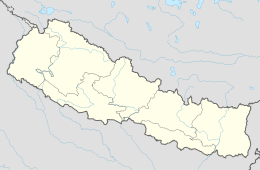Char Dham, Nepal
The Char Dham of Nepal (Nepali: नेपालको चार धाम) is a set of four Hindu religious sites in Nepal. They are Pashupat Kshetra, Mukti Kshetra, Ruru Kshetra and Baraha Kshetra.[1][2][3]
Nestled at the convergence of the Koka and Koshi rivers in Barahakshetra, Sunsari, within Nepal's Koshi Province, Barahachhetra stands as a revered pilgrimage site interwoven with Hindu and Kirat traditions. Also known as Barahakshetra or Varahakshetra, this sacred locale boasts a rich history chronicled in revered Puranas like the Brahma Purana, Varaha Purana, and Skanda Purana, further magnified by its mention in the epic Mahabharata.
The Char Dham Yatra in Nepal transcends a mere physical journey; it is a soul-stirring odyssey through diverse landscapes—towering mountains, meandering rivers, and dense forests. Pilgrims, clad in traditional attire, traverse these sacred paths, seeking blessings, absolution, and communion with the divine.
As pilgrims progress through each sacred site, the air resonates with the sounds of bells, hymns, and the rustling of prayer flags. The Yatra is not a mere ritual; it is a profound spiritual encounter that leaves an indelible mark on the hearts of those undertaking this transformative journey.
In the embrace of the Char Dham Yatra, Nepal unfolds as a tapestry of faith, culture, and natural beauty—a canvas where the spiritual and earthly converge, offering a pilgrimage that transcends the physical realm. For those seeking communion with the divine, the Char Dham Yatra in Nepal is a sacred expedition—an odyssey that etches spiritual footprints in the soul.
Pashupati Kshetra[edit]
Pashupat Kshetra is situated on the bank of holy Bagmati River in Kathmandu, the capital of Nepal. The Pashupatinath temple is the famous and sacred temple that serves the seat of pashupatinath.[4] There is harihar kshetra in place of pashupati kshetra.
Mukti Kshetra[edit]
Mukti Kshetra is situated in Mustang district[5] and is sacred to both Hindus and Buddhists.
Ruru Kshetra[edit]
Ruru Kshetra is situated on the bank of Kaligandaki river.[1] Hindus visits here during Maghe Sankranti and take holy bath in Kaligandaki river and worship in Rishikesh Temple believing to obtain moksha.

Baraha Kshetra[edit]
Baraha Kshetra is situated on the confluence of Koka and Koshi river in Sunsari district.[6]

External links[edit]
References[edit]
- ^ a b Nyaupane, Mukti Prasad. "Maghe Sankranti Fair being held in Ridi; thousands throng to take holy dip (with photos)". My Republica. Retrieved 2021-02-18.
- ^ Sansar, Nepali (2019-03-30). "Nepal's Top Pilgrimage and Holy Sites – The Abode of Spirituality". Nepali Sansar. Retrieved 2021-01-03.
- ^ "Hindu Pilgrimage Chardham Nepal | Nepal Tibet Trekking". www.nepaltibettrekking.com. Retrieved 2021-02-18.
- ^ "Pashupatinath Temple - Kathmandu, Nepal". www.sacred-destinations.com. Retrieved 2021-02-18.
- ^ "10 places you should visit in Nepal in your lifetime". OnlineKhabar English News. Retrieved 2021-02-18.
- ^ Satyal, Yajna Raj (2002). Pilgrimage Tourism in Nepal. Adroit Publishers. ISBN 978-81-87392-29-3.



